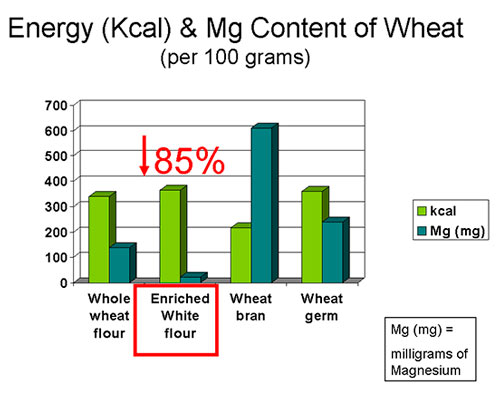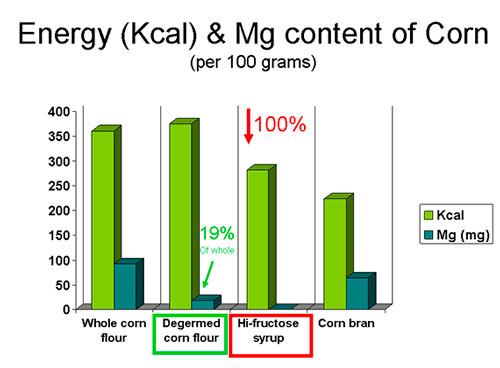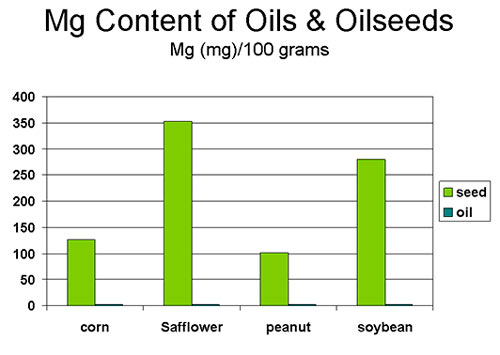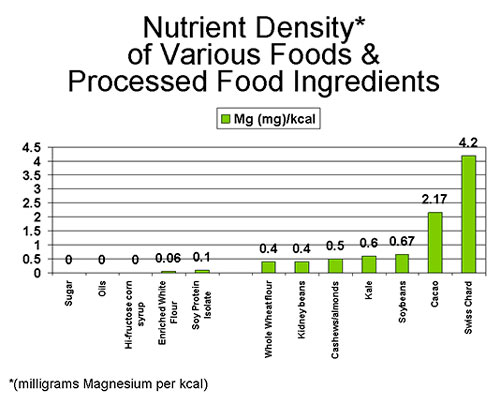Magnesium in Refined vs. Whole Foods
All Information on this page is derived from data from:
Source: U.S. Department of Agriculture, Agricultural Research Service. 2001. USDA Nutrient Database for Standard Reference, Release 14. Nutrient Data Laboratory Home Page. https://www.nal.usda.gov/fnic/foodcomp/search/
I. Wheat Flours
Energy (Kcal) & Mg Content of Wheat (per 100 grams)
Mg (mg) = milligrams of Magnesium

Summary of Wheat graph: Whole wheat contains naturally occurring magnesium, mostly in the bran and the wheat germ. When whole wheat is processed to make flour, the bran and germ are removed, and thus the resulting flour has less than 15% of the whole wheat’s natural magnesium. While flours are often “enriched” with 4 B-vitamins and iron, but are no magnesium is added back.
|
Flour type (100 g) |
Calories (Kcal) |
Magnesium (Mg) |
Magnesium per 1000 Kcal |
| Whole wheat flour | 339 | 138 | 407 |
| White, All purpose flours | 364 | 22 | 60 |
II. Whole vs. refined Corn products

Mg (mg) = milligrams of Magnesium
Summary of Corn graph: Most magnesium in natural, whole corn is in the bran. When this bran is removed via processing into corn flour, the product has lost over 80% of its natural magnesium. When corn is processed to extract its high-fructose corn syrup, widely used in processed foods of today, all the natural corn magnesium has been lost.
III. Sugar sources and sugars
|
Sugar Food (100 g) |
Calories (Kcal) |
Magnesium (mg ) |
Magnesium per 1000 Kcal |
| granulated sugar | 387 | 0 | 0 |
| brown sugar | 376 | 29 | 77 |
| molasses | 235 | 215 | 915 |
| maple sugar | 354 | 19 | 54 |
| Cane syrup | 279 | 4 | 14 |
Summary of Sugar graph: Sugar, or sucrose, is refined from sugar beets and/or sugar cane. When refined from the cane, molasses is a by-product of the refining process. The molasses contains almost all of the natural magnesium that occurs in sugar cane. Brown sugar is the refined white sugar product with molasses added to it.
IV. Magnesium in Whole Foods & Oil-Seeds compared to refined oils
|
Oil vs. Whole Food (100 g) |
Calories (Kcal) |
Magnesium (mg) |
Magnesium per 1000 Kcal |
| safflower seeds | 517 | 353 | 680 |
| safflower oil | 884 | 0 | 0 |
| olives | 115 | 4 | 35 |
| olive oil | 884 | 0 | 0 |
| peanuts | 318 | 102 | 321 |
| peanut oil | 884 | 0 | 0 |
| avocado | 161 | 39 | 242 |
| avocado oil | 884 | 0 | 0 |
| corn, cooked | 108 | 32 | 296 |
| corn oil | 884 | 0 | 0 |

V. Nutrient Density of various foods
The Bar Graph that follows is of the magnesium nutrient density of various foods: magnesium nutrient density refers to the amount of magnesium (in milligrams) one receives when consuming 1000 calories (1 kcal) of that food.
Note that the first 5 items, all products of food refining often used in processed foods, are quite low in their magnesium nutrient density while the whole foods following are much higher in how much magnesium they impart with their calories.

